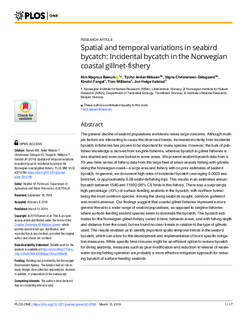Spatial and temporal variations in seabird bycatch: Incidental bycatch in the Norwegian coastal gillnet-fishery
Bærum, Kim Magnus; Anker-Nilssen, Tycho; Christensen-Dalsgaard, Signe; Fangel, Kirstin; Williams, Tom; Vølstad, Jon Helge
Peer reviewed, Journal article
Published version
Permanent lenke
http://hdl.handle.net/11250/2592252Utgivelsesdato
2019Metadata
Vis full innførselSamlinger
- Articles [3012]
- Publikasjoner fra CRIStin [3070]
Originalversjon
10.1371/journal.pone.0212786Sammendrag
The general decline of seabird populations worldwide raises large concerns. Although multiple factors are interacting to cause the observed trends, increased mortality from incidental bycatch in fisheries has proven to be important for many species. However, the bulk of published knowledge is derived from longline fisheries, whereas bycatch in gillnet fisheries is less studied and even overlooked in some areas. We present seabird bycatch data from a 10-year time-series of fishery data from the large fleet of small-vessels fishing with gillnets along the Norwegian coast—a large area and fishery with no prior estimates of seabird bycatch. In general, we document high rates of incidental bycatch (averaging 0.0023 seabirds/ net, or approximately 0.08 seabirds/fishing trip). This results in an estimated annual bycatch between 1580 and 11500 (95% CI) birds in this fishery. There was a surprisingly high percentage (43%) of surface-feeding seabirds in the bycatch, with northern fulmar being the most common species. Among the diving seabirds caught, common guillemot was most numerous. Our findings suggest that coastal gillnet fisheries represent a more general threat to a wider range of seabird populations, as opposed to longline fisheries where surface-feeding seabird species seem to dominate the bycatch. The bycatch estimates for the Norwegian gillnet-fishery varied in time, between areas, and with fishing depth and distance from the coast, but we found no clear trends in relation to the type of gillnets used. The results enabled us to identify important spatio-temporal trends in the seabird bycatch, which can allow for the development and implementation of more specific mitigation measures. While specific time closures might be an efficient option to reduce bycatch for diving seabirds, measures such as gear modification and reduction in release of wastewater during fishing operation are probably a more effective mitigation approach for reducing bycatch of surface-feeding seabirds.
